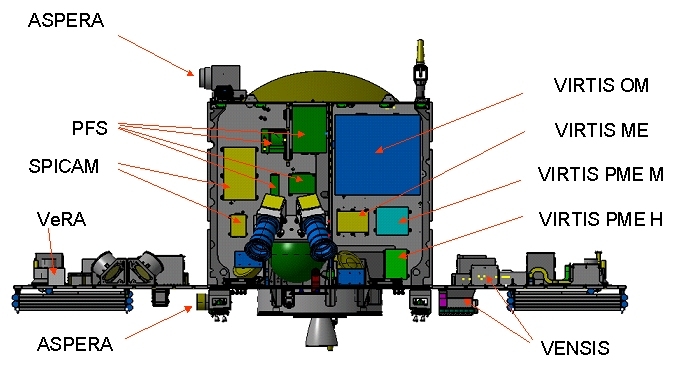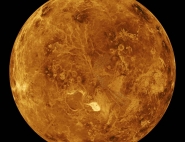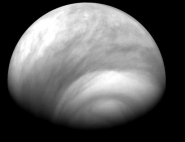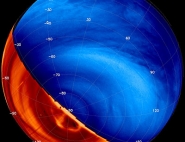April 25, 2017
Instruments
7 Instruments, 104 kg

Assembly diagram of the payload and subsystems on board Venus Express
 ASPERA-4 (Analyser of Space Plasmas and EneRgetic Atoms) was designed for the primary purpose of studying interactions between solar wind and the planet’s atmosphere. ASPREA-4 was developed from the Mars Express ASPERA-3 instrument, modified to tolerate higher temperatures and radiation levels encountered on the Venus Express mission. Using energetic neutral atoms imagery (ENA), it was able to “visualise” neutral and ionised gas concentrations around Venus. This data helped to better understand the role played by solar wind on the Venusian atmosphere’s evolution, especially the escape mechanism from the atmosphere into interplanetary space. IRAP (ex-CESR) (Co-PI: Jean-André Sauvaud) helped develop the crucial new parts for this instrument, for which the Swedish Institute of Space Physics (IRF) was the prime contractor.
ASPERA-4 (Analyser of Space Plasmas and EneRgetic Atoms) was designed for the primary purpose of studying interactions between solar wind and the planet’s atmosphere. ASPREA-4 was developed from the Mars Express ASPERA-3 instrument, modified to tolerate higher temperatures and radiation levels encountered on the Venus Express mission. Using energetic neutral atoms imagery (ENA), it was able to “visualise” neutral and ionised gas concentrations around Venus. This data helped to better understand the role played by solar wind on the Venusian atmosphere’s evolution, especially the escape mechanism from the atmosphere into interplanetary space. IRAP (ex-CESR) (Co-PI: Jean-André Sauvaud) helped develop the crucial new parts for this instrument, for which the Swedish Institute of Space Physics (IRF) was the prime contractor.
- MAG measured the magnetic field and was based on one of the Rosetta Philae lander’s instruments (ROMAP). This magnetometer was designed to measure the strength and direction of the magnetic field. This information was used to:
- provide data on the magnetic field for other combined fields, studies on particles and waves studies such as lightning, and pickup ions targeting processes;
- draw a high-resolution of the planet’s magnetosheath, magnetic barrier, ionosphere, and magnetotail; identify the limits between different plasma regions;
- and study interactions between solar wind and the planet’s atmosphere.
- The PFS (Planetary Fournier Spectrometer) was an optimised infrared spectrometer designed to study the atmosphere, operating from 1.2 to 5 µm for near-infrared and from 5 to 45 µm for far-infrared. It had a spectral resolution of 2 cm-1 and a spatial resolution of 10 km/pixel for near-infrared and 20 km/pixel for far-infrared (for an altitude of 300 km). Its primary scientific objectives were the long-term study of temperature in the planet’s lower atmosphere, measuring minor constituent variations in the atmosphere, determining the deuterium/hydrogen isotopes ratio, studying optical characteristics of aerosols (dust, ice clouds), studying the atmosphere’s net radiation and the aerosols’ impact, and studying global atmospheric circulation. The instrument’s design was based on the one on board Mars Express, modified to optimise performance on the Venus Express mission.
 SPICAV (SPectroscopy for the Investigation of the Characteristics of the Atmosphere of Venus) was a set of 3 spectrometers. The first operated in UV wavelengths (110-310 nm) and was identical to the one carried by Mars Express. The second one was an AOTF (Acousto Optic Tunable Filter) spectrometer, developed in Russia and also identical to one of Mars Express’s instruments, has a wider range (0.7-1.7 µm). Their role was to study vertical distribution of carbon dioxide, sulphur dioxide, water, dust, and cloud particles in the atmosphere. The third spectrometer was a new type of high-resolution spectrometer called SOIR (Solar Occultation in the InfraRed) and built in Belgium. It was designed to detect heavy water in the atmosphere by observing the Sun through the atmosphere in infrared wavelengths (2-4.3 µm). It represented a tremendous innovation for the mission and was developed in a very short time by LATMOS (Atmosphere, Environment and Space Observation Laboratory, France, former CNRS/IPSL Service d’Aéronomie), under the supervision of Jean-Loup Bertaux, with significant contributions from the BIRA in Brussels and the IKI in Moscow.
SPICAV (SPectroscopy for the Investigation of the Characteristics of the Atmosphere of Venus) was a set of 3 spectrometers. The first operated in UV wavelengths (110-310 nm) and was identical to the one carried by Mars Express. The second one was an AOTF (Acousto Optic Tunable Filter) spectrometer, developed in Russia and also identical to one of Mars Express’s instruments, has a wider range (0.7-1.7 µm). Their role was to study vertical distribution of carbon dioxide, sulphur dioxide, water, dust, and cloud particles in the atmosphere. The third spectrometer was a new type of high-resolution spectrometer called SOIR (Solar Occultation in the InfraRed) and built in Belgium. It was designed to detect heavy water in the atmosphere by observing the Sun through the atmosphere in infrared wavelengths (2-4.3 µm). It represented a tremendous innovation for the mission and was developed in a very short time by LATMOS (Atmosphere, Environment and Space Observation Laboratory, France, former CNRS/IPSL Service d’Aéronomie), under the supervision of Jean-Loup Bertaux, with significant contributions from the BIRA in Brussels and the IKI in Moscow.
- VeRa was a radio occultation instrument. Its goal was to examine the planet’s ionosphere, atmosphere and surface using radio waves emitted by the satellite, travelling directly through the atmosphere or reflected by the surface and received by a ground station on Earth. The instrument’s missions were: to carry out radio sounding of the ionosphere from altitudes ranging from 80 km to the ionopause (300-600 km depending on solar wind activity); to carry out radio sounding of the neutral atmosphere from altitudes ranging from the cloud cover (35-40 km) up to about 100 km; to determine the surface’s dielectric characteristics, roughness, and chemical composition; and to study the sun’s corona, the corona’s extended structures, and the solar wind’s turbulence during Venus’s superior and inferior conjunctions. VeRa used the satellite’s transponder for radio emission and reception but generated the signal using its own Ultra-Stable Oscillator (USO). VeRa’s USO design was derived from Rosetta’s Radio Science Investigation instrument (RSI).
 VIRTIS (Visible and InfraRed Thermal Imaging Spectrometer) was a visible light and infrared imaging spectrometer from the Rosetta mission. It operates in near ultraviolet, visible light, and infrared (wavelengths from 0.25 to 5 µm). This instrument offered several observation features ranging from pure high-resolution spectrometry to imaging spectrometry. VIRTIS was designed to analyse every layer in the atmosphere and clouds, measure surface temperature study interactions between the surface and the atmosphere. The CNR-IASF (Italy) was Co-PI on VIRTIS with LESIA/CNRS’s Pierre Drossart.
VIRTIS (Visible and InfraRed Thermal Imaging Spectrometer) was a visible light and infrared imaging spectrometer from the Rosetta mission. It operates in near ultraviolet, visible light, and infrared (wavelengths from 0.25 to 5 µm). This instrument offered several observation features ranging from pure high-resolution spectrometry to imaging spectrometry. VIRTIS was designed to analyse every layer in the atmosphere and clouds, measure surface temperature study interactions between the surface and the atmosphere. The CNR-IASF (Italy) was Co-PI on VIRTIS with LESIA/CNRS’s Pierre Drossart.
- VMC (Wide-angle Venus Monitoring Camera) was a wide-angle, visible light and ultraviolet camera originally developed from Mars Express and Rosetta. VMC’s objectives were to produce global context imagery for other instruments’ data; facilitate the study of dynamic processes within Venus’s atmosphere using global multi-channel imagery; help study the distribution of the unknown UV absorber above the cloud cover; monitor atmospheric glow in ultraviolet and visible light wavelengths and track its evolution as a dynamic indicator; map the luminosity distribution on the planet’s surface; and search for evidence volcanic activity. VMC images also contributed to raising public awareness for the programme. The instrument was derived from Mars Express’s HRSC (High-Resolution Spectral Camera) and Rosetta’s OSIRIS (Optical, Spectroscopic and Infrared Remote Imaging System).
Published in:


